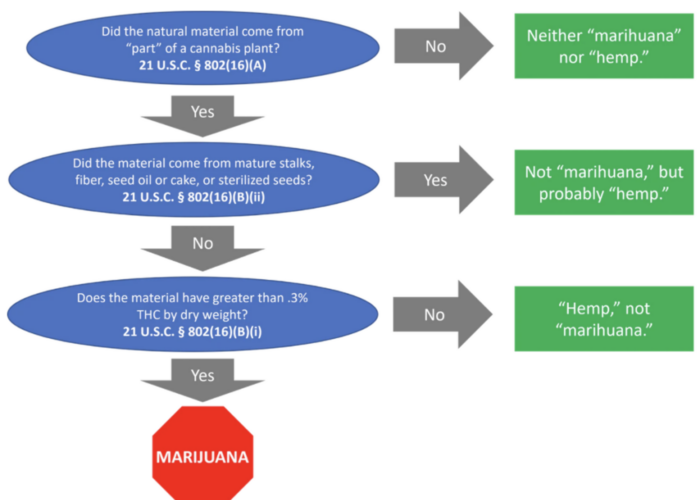Source Rule is Out, Hemp is In
by Nicole Rash
April 29, 2022 — The DEA responded to a letter by New York attorney, Shane Pennington, regarding the legality of cannabis seeds. Kyle Jaeger, DEA Says Marijuana Seeds Are Considered Legal Hemp As Long As They Don’t Exceed THC Limit, Marijuana Moment (Apr. 7, 2022), https://www.marijuanamoment.net/dea-says-marijuana-seeds-are-considered-legal-hemp-as-long-as-they-dont-exceed-thc-limit/. Although marijuana is illegal on a federal level, the 2018 Farm Bill excluded hemp from the Controlled Substances Act’s (CSA) definition of marijuana. Agriculture Improvement Act of 2018 (“2018 Farm Bill”), Pub. Law 115-334, § 12619 (2018). Hemp and marijuana plants are both the same species, but this bill allowed hemp to be grown legally so long as the cannabis plant contains 0.3 percent or less delta-9-tetrahydocannabinol, also known as THC, on a dry basis. Sian Ferguson, Hemp vs. Marijuana: What’s the Difference? Healthline, (Aug. 27, 2020), https://www.healthline.com/health/hemp-vs-marijuana. Anything above 0.3 percent THC would be considered schedule I “marihuana.”
Pennington wrote a letter with the intention to clear up the confusion over the Source Rule: the argument that the legal status of a cannabis product hinges on whether it is ‘sourced’ from marijuana or hemp. Kyle Jaeger, DEA Says Marijuana Seeds Are Considered Legal Hemp As Long As They Don’t Exceed THC Limit, Marijuana Moment (Apr. 7, 2022), https://www.marijuanamoment.net/dea-says-marijuana-seeds-are-considered-legal-hemp-as-long-as-they-dont-exceed-thc-limit/. There was confusion in the hemp industry over whether the legality of any particular sample depended on the flowers containing more than 0.3 percent or if the substance itself, like the seeds, exceeds the 0.3 percent threshold.
The DEA cleared up the confusion by acknowledging that both hemp and the plant’s seeds are generally legal as they contain nominal THC levels and is thus uncontrolled by the CSA. Because of this recognition, the DEA is saying that regardless of how THC might end up being produced in flowers if those seeds were cultivated, if the seeds themselves contain less than the THC threshold then it is legal hemp. This clarity will allow people to ask three statutory interpretation questions to determine whether a cannabis product is marijuana or hemp. Pennington’s colleague, Matt Zorn, put together a flow chart that lays out this statutory interpretation illustrating our reading of 21 U.S.C. 802(16):

The DEA letter also clarifies other open questions such as tissue culture and any other genetic material derived from the cannabis plant that does not exceed the threshold on a dry weight basis meets the definition of hemp regardless of the bud’s THC content. Although this is not precedential, this letter still has legitimacy because it was written by the DEA, a federal agency. Congress allocated power to the USDA and the DEA to oversee the program and expand statutory definitions of hemp. Mark A Mcminimy, CRS, The 2018 Farm Bill (P.L. 115-334): Summary and Side-by-Side Comparison 29 (2019). This legitimacy, although not binding, should soon define new precedence.
This rule change is significant for three reasons. First, this letter further defines hemp. This clarified definition will help streamline and create consistency within the hemp industry. As seen earlier this year, some farmers were forced to burn their hemp crops because they were no longer in compliance with the USDA ruling that all hemp must have a total THC level not to exceed 0.3 percent (sometimes called a “Hot Crop”), a change from the statute initially created in the 2018 Farm Bill, which only counts Delta-9 THC levels on a dry weight basis and pushed 42% of hemp crops over this threshold. Kyle Horan, Hemp farmers forced to destroy crops over USDA rules, News Channel 5 Nashville, (Feb. 25, 2022, 5:20 PM), https://www.newschannel5.com/news/hemp-farmers-forced-to-destroy-crops-over-usda-rules. To read more about this story here. In addition, this will allow more businesses to enter the hemp industry because this allows for a broader definition of federally legal hemp.
Second, this letter kills the Source Rule as the determination is based on the substance itself—not its source. Shane Pennington, The Source Rule is Dead, On Drugs, (Apr. 4, 2022) https://ondrugs.substack.com/p/the-source-rule-is-dead?s=r. This method was developed before the 2018 Farm Bill and while theoretically and legally correct, it is not commercial practical as it is impossible or extremely difficult to identify the source of the substance of a cannabis product. Id. Eliminating the outdated Source Rule will redirect focus on the future of hemp instead of continuously trying to make all marijuana-derived products a controlled substance.
Third, this means that delta-8 THC, an increasingly popular, psychoactive cannabinoid, is hemp and not a controlled substance under federal law. The DEA measures cannabis THC content based on delta-9 THC, but their letter did not explicitly ban delta-8 THC. Id. If DEA or Congress wanted to regulate delta-8 THC as well, they could have.
This new definition creates more opportunities for those in the hemp industry. However, opportunities come with risks. Make sure that you and your company are protected federally through trademarks, patents, and other intellectual property laws. To find out more about protections, regulations and what this DEA letter means for you, call Gleam Law.
